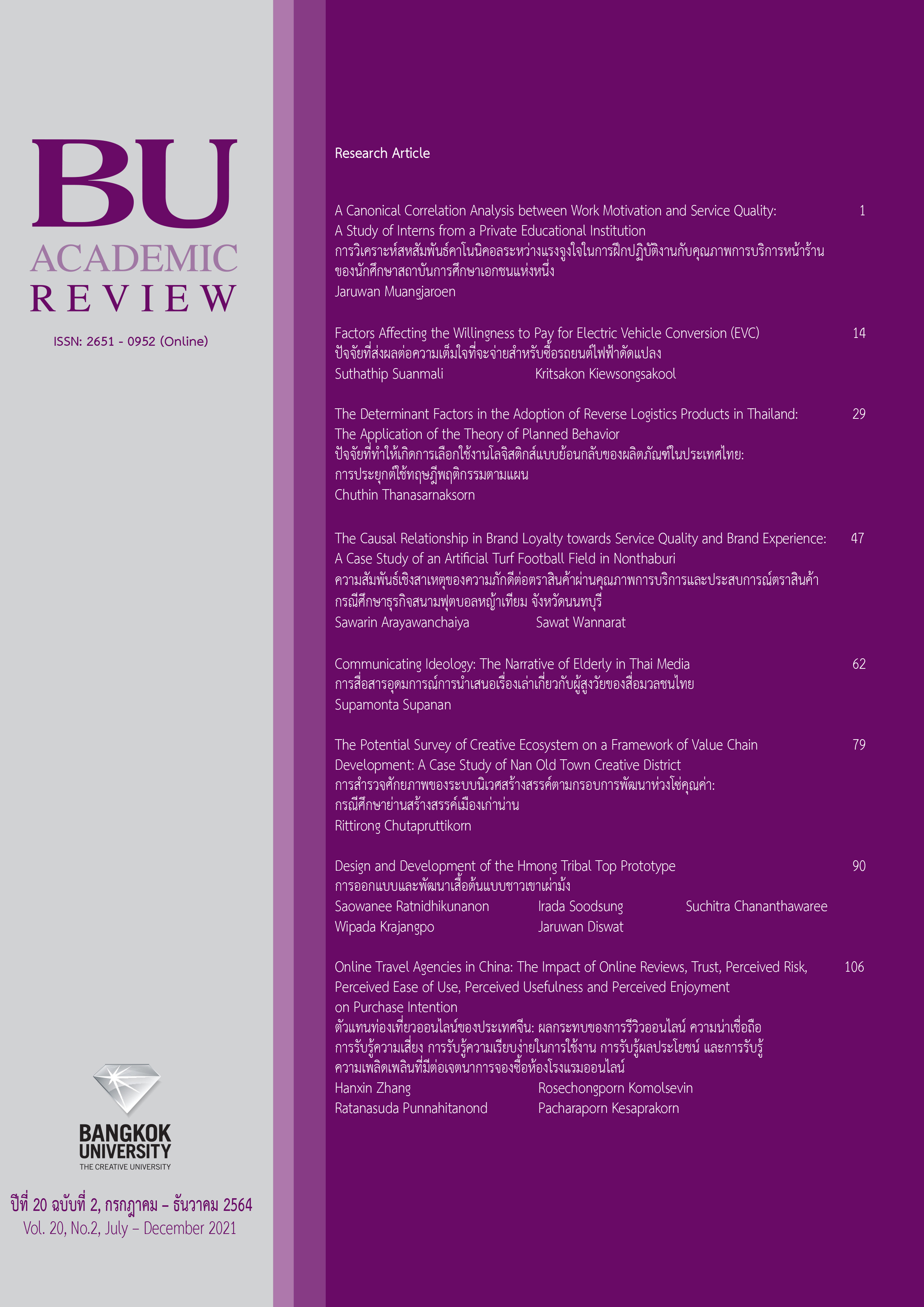Communicating Ideology: The Narrative of Elderly in Thai Media
Main Article Content
Abstract
The objectives of the study titled “Communicating Ideology: The Narrative of Elderly in Thai Media” were to examine the communicating of ideology by which the Thai media narrates the elderly; to examine the process by which the Thai media narrates the elderly; and, to examine the ideology on the elderly as held by the audience. This is a qualitative research, encompassing the subject of ideology, narrative, decoding, and encoding. The study has found a discrepancy in ideology between the non-fiction and the fiction narratives of the elderly. As for the former account, the plights of the elderly are often featured, while for the latter, fiction stories paint the positive, and idealistic portrait of the elderly. The media, teenagers, working age people, and the elderly maintain different ideologies where the narrative of elderly is concerned.
Article Details
The manuscript submitted for publication must be the original version, submitted only to this particular journal with no prior acceptance for publication elsewhere in other academic journals. The manuscript must also not violate the copyright issue by means of plagiarism.
References
Allan, L. J., & Johnson, J. A. (2008). Undergraduate attitudes toward the elderly: The role of
knowledge, contact and aging anxiety. Educational Gerontology, 35(1), 1-14. doi:10.1080/03601270802299780
Althusser, L. (1999). Ideology and ideological state of apparatuses. In J. Evans & S. Hall
(Eds.) Visual Culture: The Reader (pp.317-324). London: Sage Publication.
Barker, C. (2008). Cultural studies: Theory and practice. London: Sage Publications.
Barret, A. E., Raphael, A., & Gunderson, J. (2014). Chapter four reflections of old age,
constructions of aging selves. In C. L. Harrington, D. D. Bieley & A. R. Bardo (Eds.)
Aging, Media and Culture (pp.39-50). Lexington Books: United Kingdom.
Blix, B. H., Hamran, T., & Normann, H. K. (2013). Struggles of being and becoming: A dialogical
narrative analysis of the life stories of Sami elderly. Journal Aging Studies, 27(3), 264-275.
doi: 10.1016/j.jaging.2013.05.002
Chantavanich, S. (2011). Kān wikhro̜ khō̜mūn nai kānwičhai chœ̄ng khunnaphāp (Phim khrang thī
[Data analysis in qualitative research (10th ed.)]. Bangkok: Chulalongkorn University
Press.
Dolan, J., & Tincknell, E. (2013). Representing older women in the media: The key issues.
London: House of Commons.
Harrignton, C. L. (2014). Chapter one new areas of inquiry in aging, media, and culture.
In C. L. Harrington, D. D. Bieley & A. R. Bardo (Eds.) Aging, Media and Culture (pp.1-9).
Lexington Books: United Kingdom.
Herman, L., & Vervaeck, B. (2013). The living handbook of narratology ideology and narrative
fiction. Retrieved March 1, 2018, from http://www.lhn.uni-hamburg.de/article/ideology-and-narrative-fiction
Jacobsen, F. F. (2015). Understanding public elderly care policy in Norway: A narrative analysis
of governmental white papers. Journal of Aging Studies, 34, 199-205.
doi: 10.1016/j.jaging.2015.04.006
Kaewthep, K. (2011). Phūkhon thī lāklāi nai kānsư̄sān: Dek sattrī læ phū sūng wai [Various people
in communication studies: Children, women and the elderly]. Bangkok: Parbpim Printing.
Kaewthep, K. (2012). Sư̄ kao - sư̄ mai sanya ʻattalak ʻudomkān [Old media-new media semiology
identity ideology]. Bangkok: Parbpim Printing.
Kaewthep, K., & Hinviman, S. (2010). Sāi thān hǣng nak khit thritsadī sētthasāt kānmư̄ang kap
sư̄sān sưksā (Phim khrang thī 2) [Stream of theoreticians, political economy and communication studies (2nd ed.)]. Bangkok: Parbpim Printing.
Louiyapong, K. (2010). Kānsư̄sān kap wāt kam ʻattalak phūsūngʻāyu nai sangkhom Thai.
[Communication and identity discourses of the elderly in Thai society] (Doctoral dissertation, Faculty of Communication Arts, Chulalongkorn University).
Milner, C., Norman, K. V., & Milner, J. (2015). Chapter 4 the media portrayal of ageing.
Retrieved March 1, 2018, from https://vdocuments.mx/chapter-4-the-medias-portrayal-of-ageing.html
Nimrod, G. (2008). Retirement and tourism themes in retirees’ narratives. Annals of
Tourism Research, 35(4), 859-878. doi:https://doi.org/10.1016/j.annals.2008.06.001
Prieler, M., Kohlbacher, F., Hagiwara, S., & Arima, A. (2015). The representation of older
people in television advertisements and social change: The case of Japan. Ageing and Society, 35(4), 865-887. doi:10.1017/S0144686X1400004X
Samlee, M. (2007). Tūalakhō̜n phūsūngʻāyu nai nawaniyāi Thai Phō̜.Sō̜. sō̜ngphanhārō̜iyīsiphā -
sō̜ngphanhārō̜isīsippǣt [Elderly characters in Thai novels 1982-2005] (Master’s thesis,
Chulalongkorn University).
Thaweesit, S. (2010). Botbannāthikān: Kān plīan krabūan that phư̄a kānwičhai phūsūngʻāyu.
[Editorial: A Paradigm Shift for Aging Research]. In S. Thaweesit & S. Boonyamanoon (Eds.) Prachākō̜n læ sangkhom sō̜ngphanhārō̜ihāsipsām: khunkhā phūsūngʻāyu nai sāitā sangkhom Thai [Population and society 2010: Value of the elderly from the eyes of Thai society] (pp.1-11). Nakhon Pathom: Institute for Population and Social Research.
Vernon, J. A., Williams, J. A., Phillips, T., & Wilson, J. (1991). Media stereotyping: A comparison of the way elderly women and men are portrayed on prime-time television. Journal of Women & Aging, 2(4), 55-68. doi:10.1300/J074v02n04_05
Vickers, K. (2007). Aging and the media: Yesterday, today, and tomorrow. California Journal of
Health Promotion, 5(3), 100–105.
Walker, J. (2010). Elder stereotypes in media & popular culture. Retrieved March 1, 2018, from
http://www.agingwatch.com/?p=439
Wapattanawong, P., & Prasartkul, P. (2017). Prachākō̜n Thai nai ʻanākhot [Thai population in the
future]. Retrieved March 7, 2018, from http://www.ipsr.mahidol.ac.th/IPSR/Annual
Conference/ConferenceII/Article/Article02.htm
Wilinska, M., & Henning, C. (2011). Old age identity in social welfare practice. Qualitative Social Work, 10(3), 346-363. doi:10.1177/1473325011409477


